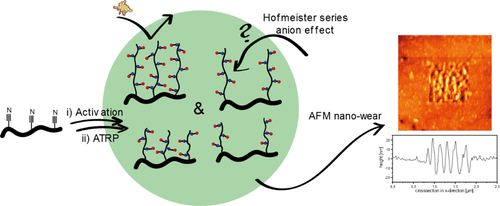当前位置:
X-MOL 学术
›
ACS Appl. Polym. Mater.
›
论文详情
Our official English website, www.x-mol.net, welcomes your feedback! (Note: you will need to create a separate account there.)
Zwitterion Polymer Brushes on Porous Membranes: Characterization, Tribology, Performance, and the Effect of Electrolyte Anions
ACS Applied Polymer Materials ( IF 5 ) Pub Date : 2020-09-17 , DOI: 10.1021/acsapm.0c00686 Eric Ziemann 1 , Tali Coves 1 , Orly Levin 1 , Roy Bernstein 1
ACS Applied Polymer Materials ( IF 5 ) Pub Date : 2020-09-17 , DOI: 10.1021/acsapm.0c00686 Eric Ziemann 1 , Tali Coves 1 , Orly Levin 1 , Roy Bernstein 1
Affiliation

|
Herein, we present a two-step activation process to achieve surface-initiated atom transfer radical polymerization (ATRP) and covalently grafted poly(sulfobetaine methacrylate) polyzwitterion brushes with controlled density and thickness on polyacrylonitrile (PAN) ultrafiltration membrane surfaces. The activation is based on the known amidoxime synthesis on PAN membrane surfaces, with subsequent mixed oxadiazole formation to incorporate the ATRP initiator. Successful grafting and the differences in brush density and thickness were verified by X-ray photoelectron spectroscopy, attenuated total reflection Fourier transform infrared spectroscopy, and atomic force microscopy (AFM). Specifically, we qualitatively show the differences in the brush interface layers by using lateral force microscopy (LFM) with a colloidal AFM probe and through nanowear experiments using a sharp AFM tip. All brush interfaces showed reduced friction in LFM and unique stick-slip behavior and ripple formation as a nanowear mode. We also show that the molecular weight cutoff and permeability vary with the brush properties and that both high- and low-density brushes offer superior antifouling properties against alginate compared to a pristine PAN membrane. Finally, we analyze how Hofmeister series anions affect filtration with 0.01, 0.1, and 0.5 mol L–1 KCl, KBr, KSCN, K2SO4, and K2HPO4 solutions. The results reveal a positive flux effect for KCl, KBr, and KSCN and a negative one for K2SO4 and K2HPO4 solutions, suggesting that the brushes are grafted mostly to the surface, crowding the pore mouth in the media with strongly hydrated counterions. Overall, this work provides a method for preparing well-controlled polymer brushes on porous membranes to produce membranes with excellent antifouling properties.
中文翻译:

两性离子聚合物在多孔膜上的刷:表征,摩擦学,性能和电解质阴离子的影响。
在这里,我们提出了一个两步激活过程,以实现表面引发的原子转移自由基聚合(ATRP)和在聚丙烯腈(PAN)超滤膜表面上具有可控制的密度和厚度的共价接枝的聚(磺基甜菜碱甲基丙烯酸甲酯)聚两性离子刷。活化是基于PAN膜表面上已知的a胺肟合成,随后形成混合的恶二唑并掺入ATRP引发剂。通过X射线光电子能谱,衰减全反射傅里叶变换红外光谱和原子力显微镜(AFM)验证了嫁接成功以及刷子密度和厚度的差异。特别,我们通过使用带有胶体AFM探针的侧向力显微镜(LFM)以及使用锋利的AFM尖端的纳米磨损实验,定性地显示了刷子界面层的差异。所有的刷界面都显示出降低的LFM摩擦力以及独特的粘滑行为和波纹形成(作为纳米磨损模式)。我们还表明,分子量截留率和渗透性随刷子的性能而变化,并且与原始PAN膜相比,高密度和低密度刷子对藻酸盐均具有出色的防污性能。最后,我们分析Hofmeister系列阴离子如何影响0.01、0.1和0.5 mol L的过滤 我们还表明,分子量截留率和渗透性随刷子性能的不同而变化,与原始PAN膜相比,高密度和低密度刷子对藻酸盐均具有出色的防污性能。最后,我们分析Hofmeister系列阴离子如何影响0.01、0.1和0.5 mol L的过滤 我们还表明,分子量截留率和渗透性随刷子的性能而变化,并且与原始PAN膜相比,高密度和低密度刷子对藻酸盐均具有出色的防污性能。最后,我们分析Hofmeister系列阴离子如何影响0.01、0.1和0.5 mol L的过滤–1 KCl,KBr,KSCN,K 2 SO 4和K 2 HPO 4解决方案。结果表明,KCl,KBr和KSCN的助焊剂作用为正,而K 2 SO 4和K 2 HPO 4溶液的助焊剂作用为负,这表明刷子主要接枝到了表面上,从而使刷子的孔口非常密集。水合抗衡离子。总的来说,这项工作提供了一种在多孔膜上制备控制良好的聚合物刷以生产具有优异防污性能的膜的方法。
更新日期:2020-11-13
中文翻译:

两性离子聚合物在多孔膜上的刷:表征,摩擦学,性能和电解质阴离子的影响。
在这里,我们提出了一个两步激活过程,以实现表面引发的原子转移自由基聚合(ATRP)和在聚丙烯腈(PAN)超滤膜表面上具有可控制的密度和厚度的共价接枝的聚(磺基甜菜碱甲基丙烯酸甲酯)聚两性离子刷。活化是基于PAN膜表面上已知的a胺肟合成,随后形成混合的恶二唑并掺入ATRP引发剂。通过X射线光电子能谱,衰减全反射傅里叶变换红外光谱和原子力显微镜(AFM)验证了嫁接成功以及刷子密度和厚度的差异。特别,我们通过使用带有胶体AFM探针的侧向力显微镜(LFM)以及使用锋利的AFM尖端的纳米磨损实验,定性地显示了刷子界面层的差异。所有的刷界面都显示出降低的LFM摩擦力以及独特的粘滑行为和波纹形成(作为纳米磨损模式)。我们还表明,分子量截留率和渗透性随刷子的性能而变化,并且与原始PAN膜相比,高密度和低密度刷子对藻酸盐均具有出色的防污性能。最后,我们分析Hofmeister系列阴离子如何影响0.01、0.1和0.5 mol L的过滤 我们还表明,分子量截留率和渗透性随刷子性能的不同而变化,与原始PAN膜相比,高密度和低密度刷子对藻酸盐均具有出色的防污性能。最后,我们分析Hofmeister系列阴离子如何影响0.01、0.1和0.5 mol L的过滤 我们还表明,分子量截留率和渗透性随刷子的性能而变化,并且与原始PAN膜相比,高密度和低密度刷子对藻酸盐均具有出色的防污性能。最后,我们分析Hofmeister系列阴离子如何影响0.01、0.1和0.5 mol L的过滤–1 KCl,KBr,KSCN,K 2 SO 4和K 2 HPO 4解决方案。结果表明,KCl,KBr和KSCN的助焊剂作用为正,而K 2 SO 4和K 2 HPO 4溶液的助焊剂作用为负,这表明刷子主要接枝到了表面上,从而使刷子的孔口非常密集。水合抗衡离子。总的来说,这项工作提供了一种在多孔膜上制备控制良好的聚合物刷以生产具有优异防污性能的膜的方法。



























 京公网安备 11010802027423号
京公网安备 11010802027423号